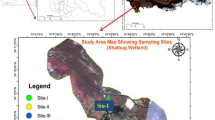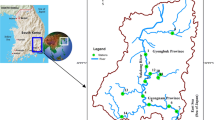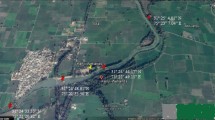Abstract
Heavy metals are one of the main problems in aquatic systems as they affect the ecological balance of the water body. Biological availability of a metal is dependent on its chemical form. Speciation of metals in aquatic systems is of high importance and can provide a proper framework for managers to determine the probable risks resulted from metals. Therefore, this study was performed in Anzali Wetland to investigate the speciation of heavy metals and metalloids, and determine the factors controlling them. For this purpose, six stations were sampled and the relations among water quality parameters were identified by cluster analysis. Water chemistry software (HSC Chemistry) was used to draw Eh/pH diagrams. According to the results, oxidation–reduction potential (Eh) values ranged from − 280 to + 135 mV. The metals including arsenic (As), cadmium (Cd), cobalt (Co), chromium (Cr), mercury (Hg), cerium (Ce), copper (Cu), aluminum (Al) and iron (Fe) were affected by Eh and pH. Salinity played a significant role in controlling nickel (Ni), magnesium (Mg), calcium (Ca) and strontium (Sr) in the water. The HSC Chemistry diagrams showed that all the studied metals were within the two lines of water stability range. As, Cd, Co, Cr, Ni, lead (Pb), Al, Ca, Ce, Fe, manganese (Mn), Mg, silicon (Si) and Sr were present in a bioavailable species in the wetland water. Some metals such as As, Cd, Cr, and Fe existed in very toxic forms. It was found that changes in the Eh–pH values as a result of anthropogenic and different activities in the wetland can alter the speciation of metals. Eh/pH diagrams also showed that the elements can exceed the water stability range and become unstable in three states (pH < 5, Eh < − 380 mV or Eh > 780 mV).










Similar content being viewed by others
References
Adel M, Dadar M, Fakhri Y, Oliveri Conti G, Ferrante M (2016) Heavy metal concentration in muscle of pike (Esox lucius Linnaeus, 1758) from Anzali international wetland, southwest of the Caspian Sea and their consumption risk assessment. Toxin Rev 35(3–4):217–223. https://doi.org/10.1080/15569543.2016.1223694
Alhashemi AH, Sekhavatjou MS, Kiabi BH, Karbassi AR (2012) Bioaccumulation of trace elements in water, sediment, and six fish species from a freshwater wetland, Iran. Microchem J 104:1–6. https://doi.org/10.1016/j.microc.2012.03.002
Allen HE, Hall RH, Brisbin TD (1980) Metal speciation. Effects on aquatic toxicity. Environ Sci Technol 14(4):441–443. https://doi.org/10.1021/es60164a002
Alonso E, Santos A, Callejón M, Jiménez JC (2004) Speciation as a screening tool for the determination of heavy metal surface water pollution in the Guadiamar river basin. Chemosphere 56(6):561–570. https://doi.org/10.1016/j.chemosphere.2004.04.031
American Public Health Association (APHA) (2005) Standard methods for the examination of water and wastewater, 21st edn. American Public Health Association, Washington, DC, p 1220p
Ashja AA, Khoushkhou Z, Rabani M, Moeini S (2007) Comparative study for heavy metal concentration (Zn, Cu, Pb, Cd and Hg) in water, sediments and soft tissue of Anzali lagoon anodont (Anodonta cygnea) sampled in two seasons, Autumn and Spring (1383–1384). Sci Inf Database 19(4):103–113
Bai J, Xiao R, Zhang K, Gao H (2012) Arsenic and heavy metal pollution in wetland soils from tidal freshwater and salt marshes before and after the flow-sediment regulation regime in the Yellow River Delta, China. J Hydrol 450:244–253. https://doi.org/10.1016/j.jhydrol.2012.05.006
Beidokhti MZ, Naeeni STO, AbdiGhahroudi MS (2019) Biosorption of nickel(II) from aqueous solutions onto pistachio hull waste as a low-cost biosorbent. Civ Eng J 5(2):447–457
Brraich OS, Jangu S (2015) Evaluation of water quality pollution indices for heavy metal contamination monitoring in the water of Harike Wetland (Ramsar Site), India. Int J Sci Res Publ 5(2):1–6
Campbell PG (1994) Interactions between trace metals and aquatic organisms: a critique of the free-ion activity model. Metal Speciat Bioavailab 6:45–102
Da Silva MR, Lamotte M, Donard OFX, Soriano-Sierra EJ, Robert M (1996) Metal contamination in surface sediments of mangroves, lagoons and Southern Bay in Florianopolis Island. Environ Technol 17(10):1035–1046. https://doi.org/10.1080/09593331708616473
Da̧browski A, Hubicki Z, Podkościelny P, Robens E (2004) Selective removal of the heavy metal ions from waters and industrial wastewaters by ion-exchange method. Chemosphere 56(2):91–106. https://doi.org/10.1016/j.chemosphere.2004.03.006
Ebrahimpour M, Pourkhabbaz A, Baramaki R, Babaei H, Rezaei M (2011) Bioaccumulation of heavy metals in freshwater fish species, Anzali, Iran. Bull Environ Contam Toxicol 87(4):386. https://doi.org/10.1007/s00128-011-0376-y
Esmaeilzadeh M, Karbassi A, Moattar F (2016) Assessment of metal pollution in the Anzali Wetland sediments using chemical partitioning method and pollution indices. Acta Oceanol Sin 35(10):28–36. https://doi.org/10.1007/s13131-016-0920-z
Ferguson JF, Gavis J (1972) A review of the arsenic cycle in natural waters. Water Res 6(11):1259–1274. https://doi.org/10.1016/0043-1354(72)90052-8
Förstner U, Wittmann GT (2012) Metal pollution in the aquatic environment, 2nd revised edn. Springer, Berlin
Frimmel FH, Gremm T (1994) The importance of element speciation in water analysis-a plea for further investigations. Fresenius’ J Anal Chem 350(1–2):7–13
Glasby GP, Schulz HD (1999) Eh, PH diagrams for Mn, Fe Co, Ni, Cu and as under seawater conditions: application of two new types of Eh, PH diagrams to the study of specific problems in marine geochemistry. Aquat Geochem 5(3):227–248
Gupta B, Kumar R, Rani M (2013) Speciation of heavy metals in water and sediments of an urban lake system. J Environ Sci Health A 48(10):1231–1242
Hargalani FZ, Karbassi A, Monavari SM, Azar PA (2014) A novel pollution index based on the bioavailability of elements: a study on Anzali wetland bed sediments. Environ Monit Assess 186(4):2329–2348. https://doi.org/10.1007/s10661-013-3541-4
Hem JD (1960) Some chemical relationships among sulfur species and dissolved ferrous iron. USGPO, Washington. https://doi.org/10.3133/wsp1459C
Hong YS, Kinney KA, Reible DD (2011) Effects of cyclic changes in pH and salinity on metals release from sediments. Environ Toxicol Chem 30(8):1775–1784. https://doi.org/10.1002/etc.584
Huang HH (2016) The Eh–pH diagram and its advances. Metals 6(1):23. https://doi.org/10.3390/met6010023
Imanpour Namin J (2011) Heavy metals Cu, Zn, Cd and Pb in tissue, liver of Esox lucius and sediment from the Anzali international lagoon-Iran. Casp J Environ Sci 9(1):1–8
Jamshidi-Zanjani A, Saeedi M (2013) Metal pollution assessment and multivariate analysis in sediment of Anzali international wetland. Environ Earth Sci 70(4):1791–1808. https://doi.org/10.1007/s12665-013-2267-5
Japan International cooperation Agency (JICA) (2005) The study on integrated management for ecosystem conservation of the Anzali wetland in the Islamic Republic of Iran. Department of the environment, Ministry of Jihad-E-agriculture, Iran
Karbassi AR, Heidari M (2015) An investigation on role of salinity, pH and DO on heavy metals elimination throughout estuarial mixture. Global J Environ Sci Manag 1(1):41–46. https://doi.org/10.7508/gjesm.2015.01.004
Karbassi AR, Tajziehchi S, Khoshghalb H (2018) Speciation of heavy metals in coastal water of Qeshm Island in the Persian Gulf. Global J Environ Sci Manag 4(1):91–98. https://doi.org/10.22034/gjesm.2018.04.01.009
Kazi TG, Arain MB, Jamali MK, Jalbani N, Afridi HI, Sarfraz RA, Shah AQ (2009) Assessment of water quality of polluted lake using multivariate statistical techniques: a case study. Ecotoxicol Environ Saf 72(2):301–309. https://doi.org/10.1016/j.ecoenv.2008.02.024
Kim JH, Gibb HJ, Howe PD, World Health Organization (2006) Cobalt and inorganic cobalt compounds. Concise International Chemical Assessment Document 69. http://who.int/ipcs/publications/cicad/cicad69%20.pdf
Kovach WL (1999) MVSP-A multivariate statistical Package for Windows, ver. 3.1. Kovach Computing Services, Pentraeth, Wales, UK, 137
McKenna JE Jr (2003) An enhanced cluster analysis program with bootstrap significance testing for ecological community analysis. Environ Model Softw 18(3):205–220. https://doi.org/10.1016/S1364-8152(02)00094-4
Merian E, Clarkson TW (1991) Metals and their compounds in the environment. VCH, Weinheim
Mirzajani AR, Babaei H, Abedini A, Dadi GA (2010) Eutrophication trend of Anzali wetland based on 1992–2002 data. J Environ Stud 35(52):19–21
Nasiri EF, Kebria DY, Qaderi F (2018) An experimental study on the simultaneous phenol and chromium removal from water using titanium dioxide photocatalyst. Civ Eng J 4(3):585–593
Nkansah MA, Donkoh M, Akoto O, Ephraim JH (2019) Preliminary studies on the use of sawdust and peanut shell powder as adsorbents for phosphorus removal from water. Emerg Sci J 3(1):33–40
Nkontcheu DBK, Tchamadeu NN, Ngealekeleoh F, Nchase S (2017) Ecotoxicological effects of imidacloprid and Lambda-Cyhalothrin (Insecticide) on Tadpoles of the African common toad, Amietophrynus regularis (Reuss, 1833) (Amphibia: Bufonidae). Emerg Sci J 1(2):49–53
Nodoushan EJ (2018) Monthly forecasting of water quality parameters within Bayesian networks: a case study of Honolulu, Pacific Ocean. Civ Eng J 4(1):188–199
Nyingi B, Gitahi KJ, Kiptoo M, Jackson K (2016) Heavy metal concentrations in water and selected fish species (tilapia, cat fish and lung fish) from lake Baringo, Kenya. Int J Sci Environ Technol 5(6):4288–4295
Parkhurst DL, Appelo CAJ (1999) User’s guide to PHREEQC (Version 2): a computer program for speciation, batch-reaction, one-dimensional transport, and inverse geochemical calculations. Water-Resour Invest Rep 99(4259):312
Pourang N, Richardson CA, Mortazavi MS (2010) Heavy metal concentrations in the soft tissues of swan mussel (Anodonta cygnea) and surficial sediments from Anzali wetland, Iran. Environ Monit Assess 163(1–4):195–213. https://doi.org/10.1007/s10661-009-0827-7
Roine A (2002) Outokumpu HSC chemistry for windows: chemical reaction and equilibrium software with extensive thermochemical database. Outokumpu Research OY, Pori
Salamat N, Movahedinia A, Etemadi-Deylami E, Mohammadi Y (2015) Pike (Esox lucius) bio-indicator of heavy metal pollution in Anzali Wetland. Water Qual Expos Health 7(2):251–254. https://doi.org/10.1007/s12403-014-0138-2
Sartaj M, Fatollahi F, Filizadeh Y (2005) An investigation of the evolution of distribution and accumulation of heavy metals (Cr, Ni, Cu, Cd, Zn and Pb) in Anzali wetland’s sediments. Iran J Nat Resour 58(3):623–634
Shin PKS, Lam WKC (2001) Development of a marine sediment pollution index. Environ Pollut 113(3):281–291. https://doi.org/10.1016/S0269-7491(00)00192-5
Singh N, Kaur M, Katnoria JK (2017) Analysis on bioaccumulation of metals in aquatic environment of Beas River Basin: a case study from Kanjli wetland. GeoHealth 1(3):93–105
Tabatabaie T, Ghomi MR, Amiri F, Zamani-ahmadmahmoodi R (2011) Comparative study of mercury accumulation in two fish species, (Cyprinus carpio and Sander lucioperca) from Anzali and Gomishan wetlands in the southern coast of the Caspian Sea. Bull Environ Contam Toxicol 87(6):674–677. https://doi.org/10.1007/s00128-011-0413-x
Thorslund J, Jarsjö J, Wällstedt T, Mörth CM, Lychagin MY, Chalov SR (2017) Speciation and hydrological transport of metals in non-acidic river systems of the Lake Baikal basin: field data and model predictions. Reg Environ Change 17(7):2007–2021. https://doi.org/10.1007/s10113-016-0982-7
Tipping E (1994) WHAMC—a chemical equilibrium model and computer code for waters, sediments, and soils incorporating a discrete site/electrostatic model of ion-binding by humic substances. Comput Geosci 20(6):973–1023. https://doi.org/10.1016/0098-3004(94)90038-8
Xu FL, Tao S, Dawson RW, Li BG (2001) A GIS-based method of lake eutrophication assessment. Ecol Model 144(2–3):231–244. https://doi.org/10.1016/S0304-3800(01)00374-X
Yazdi RB, Ebrahimpour M, Mansouri B, Rezaei MR, Babaei H (2012) Contamination of metals in tissues of Ctenopharyngodon idella and Perca fluviatilis from Anzali Wetland, Iran. Bull Environ Contam Toxicol 89(4):831–835
Zafarzadeh A, Bay A, Fakhri Y, Keramati H, Hosseini Pouya R (2018) Heavy metal (Pb, Cu, Zn, and Cd) concentrations in the water and muscle of common carp (Cyprinus carpio) fish and associated non-carcinogenic risk assessment: alagol wetland in the Golestan, Iran. Toxin Rev 37(2):154–160. https://doi.org/10.1080/15569543.2017.1386684
Zhang M, Cui L, Sheng L, Wang Y (2009) Distribution and enrichment of heavy metals among sediments, water body and plants in Hengshuihu Wetland of Northern China. Ecol Eng 35(4):563–569. https://doi.org/10.1016/j.ecoleng.2008.05.012
Acknowledegments
The authors are thankful to the University of Tehran for providing the necessary facilities for conducting this study. The authors also like to thank the Syrian Ministry of Higher Education for giving the first author the opportunity to do research in Iran.
Author information
Authors and Affiliations
Corresponding author
Additional information
Editorial responsibility: M. Abbaspour.
Rights and permissions
About this article
Cite this article
ALabdeh, D., Karbassi, A.R., Omidvar, B. et al. Speciation of metals and metalloids in Anzali Wetland, Iran. Int. J. Environ. Sci. Technol. 17, 1411–1424 (2020). https://doi.org/10.1007/s13762-019-02471-8
Received:
Revised:
Accepted:
Published:
Issue Date:
DOI: https://doi.org/10.1007/s13762-019-02471-8




